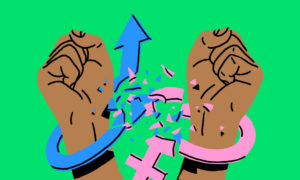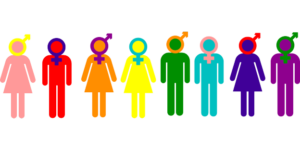In publishing, we can strive to create publications that are inclusive to all identities, serving both writers and readers. But what are some questions we can ask to create an environment with these attributes when it comes to gender identity? And how can we continue to question our assumptions and create an evolving, flexible approach to the language we use to talk about gender?
When we talk about gender, it’s important to understand what this may cover. The AMA Manual of Style defines gender as “more than [biological] sex and serves as a cultural indicator of a person’s personal and social identity.”
Does the language need to be gendered?
When gender is being written about, in order to ensure that the words are portraying what was intended, there are some general questions we can ask. For example, is gender being referred to unnecessarily? Could the same meaning be conveyed with a different, more accurate phrase, or is the reference to gender intentional and necessary for the context?
For example, there are some gendered terms that may be inaccurate to the intended group: waitressing (which could be changed to “table service”), mailmen (“postal workers”), and maternity (“perinatal”) are all terms that can be swapped with more accurate alternatives. When considering these words, what do they imply, and what is intended to be implied?

In addition to word choice, something else to think about is gendered honorific prefixes like “Mr.” or “Ms.” These are often used in submission systems or the acknowledgments section of a paper, but are they inclusive of everyone who might use the submission systems or be acknowledged? The person being referred to with these forms may have a nonbinary gender identity or prefer not to use these terms. Would the meaning be the same if a gender-neutral alternative like “Mx.” was added as an option or if gendered prefixes were removed?
In terms of content and copyediting, it may be helpful to look at what other publications and style guides say. For example, on reporting sex and gender in studies, the AMA Manual of Style has this to say: “An important consideration when referring to sex is the level of specificity required: specify sex when it is relevant. In research articles, sex/gender should be reported and defined, and how sex/gender was assessed should be described.”
Some journals, such as the Journal of Midwifery & Women’s Health, have moved toward “intentional inconsistency,” “allowing authors to choose the language related to gender that they believe is best for their manuscript” while paying close attention to preferred language in ongoing conversations.*
How can we handle pronouns?
There are some more questions we can consider. What does your style guide say about gender pronouns? When referring to a nonspecific person, are terms like “he/she” used, are gender pronouns avoided, or is a gender-neutral pronoun like “they” used? What groups do each of these choices include or leave out?
Is there an opportunity for employees to provide their gender pronouns if they prefer, in either an email signature, their LinkedIn page, or somewhere else?
What assumptions does the language imply?
In a given publication, are phrases like “opposite sex” or “both sexes” used? This assumes that only male and female sexes are possible, which does not include intersex or nonbinary identities. Is there an opportunity to be more specific? What group is specifically meant when using the term “opposite sex”?

Where can I find more resources about the language surrounding gender?
Of course, one of the most important questions to answer when looking at language surrounding gender is where to look for answers. One way to answer these questions is to look in an overarching style guide. AMA has sections on “Sex/Gender” and “Correct and Preferred Usage of Common Words and Phrases.” The AP Stylebook’s entry on gender and sexuality and the Chicago Manual of Style’s chapter on “Bias-Free Language” are useful resources. APA Style has helpful entries on gender, singular “they” pronouns, and “General Principles for Reducing Bias.”
In addition, websites like the Conscious Style Guide have gathered numerous resources on writing about gender. The GLAAD Media Reference Guide includes a glossary of preferred terms, and the freelance copy editor Alex Kapitan put together “The Radical Copyeditor’s Style Guide for Writing about Transgender People” in 2017.
Using resources like these, we can strive to be more accurate and inclusive in our use of language. Although there is more to learn every day, if our aim is to ask questions, learn more about what words convey, and consider how to choose the terms that best represent the groups we write about, we can achieve these goals.
Article contribution by J&J Copy Editor Carson Risser.
*Many thanks to Susan Rodriguez for providing this information.
